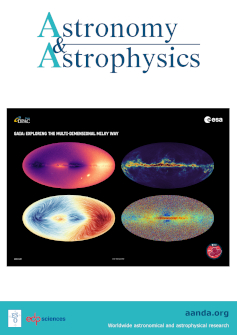寻找来自年轻的近距离行星主恒星HIP 67522的行星引起的无线电信号
IF 5.4
2区 物理与天体物理
Q1 ASTRONOMY & ASTROPHYSICS
引用次数: 0
摘要
HIP 67522是一颗年龄为17迈的1.2 M⊙矮星。它是已知的唯一一颗拥有两颗近距离气态巨行星的年轻恒星。这颗内行星的轨道可能离它的宿主足够近,可以为磁星-行星相互作用提供动力。在无线电领域,磁星-行星相互作用预计会产生一个独特的特征:电子回旋脉泽发射(ECME),与近地行星的轨道同步发射。我们对一颗G矮星主星进行了迄今为止最长的无线电监测活动,以寻找ECME,在5个月的时间里,利用澳大利亚望远镜紧凑阵列(ATCA)在1.1 - 3.1 GHz之间对HIP 67522进行了总计135小时的监测。我们发现HIP 67522在射电中是活跃的,其发射随机变化,占空比在0.24 mJy以上为69%,并且频繁爆发。爆发和静止发射都符合标准的g本文章由计算机程序翻译,如有差异,请以英文原文为准。
Searching for planet-induced radio signals from the young close-in planet host star HIP 67522
HIP 67522 is a 17 Myr old 1.2 M⊙ dwarf. It is the only such young star known to host two close-in gas giant planets. The inner planet likely orbits close enough to its host to power magnetic star-planet interactions. In the radio domain, magnetic star-planet interaction is expected to produce a unique signature: electron cyclotron maser emission (ECME), beamed in phase with the orbit of the close-in planet. We conducted the longest radio monitoring campaign of a G dwarf host star to date to search for ECME, totaling 135 h on HIP 67522 over a period of five months with the Australia Telescope Compact Array (ATCA) between 1.1 – 3.1 GHz. We find that HIP 67522 is active in the radio, with emission that varies stochastically, with a duty cycle of 69% above 0.24 mJy, and frequent bursts. Both the bursts and the quiescent emission are consistent with the canonical Güdel-Benz relation, and show a positive spectral index and brightness temperatures ≥ 1010 K, indicating likely a flaring origin. Our observations cover 61% of the innermost planet’s orbit, including multiple visits of the quadrature where planet-induced ECME detection is most likely for this system. However, no orbital modulation or persistent polarization of the radio emission was detected. Our upper limit on circularly polarized emission from HIP 67522 suggests a <0.7% conversion efficiency of the magnetic power generated in the star-planet interaction into radio waves, unless the emission was missed by our phase or frequency coverage, or was absorbed in the circumstellar plasma. HIP 67522 is a system with one of the highest expected powers of star-planet interaction among known systems and shows strong indication of planet-induced flaring, motivating observations at other wavelengths to probe for additional dissipation pathways.
求助全文
通过发布文献求助,成功后即可免费获取论文全文。
去求助
来源期刊

Astronomy & Astrophysics
地学天文-天文与天体物理
CiteScore
10.20
自引率
27.70%
发文量
2105
审稿时长
1-2 weeks
期刊介绍:
Astronomy & Astrophysics is an international Journal that publishes papers on all aspects of astronomy and astrophysics (theoretical, observational, and instrumental) independently of the techniques used to obtain the results.
 求助内容:
求助内容: 应助结果提醒方式:
应助结果提醒方式:


